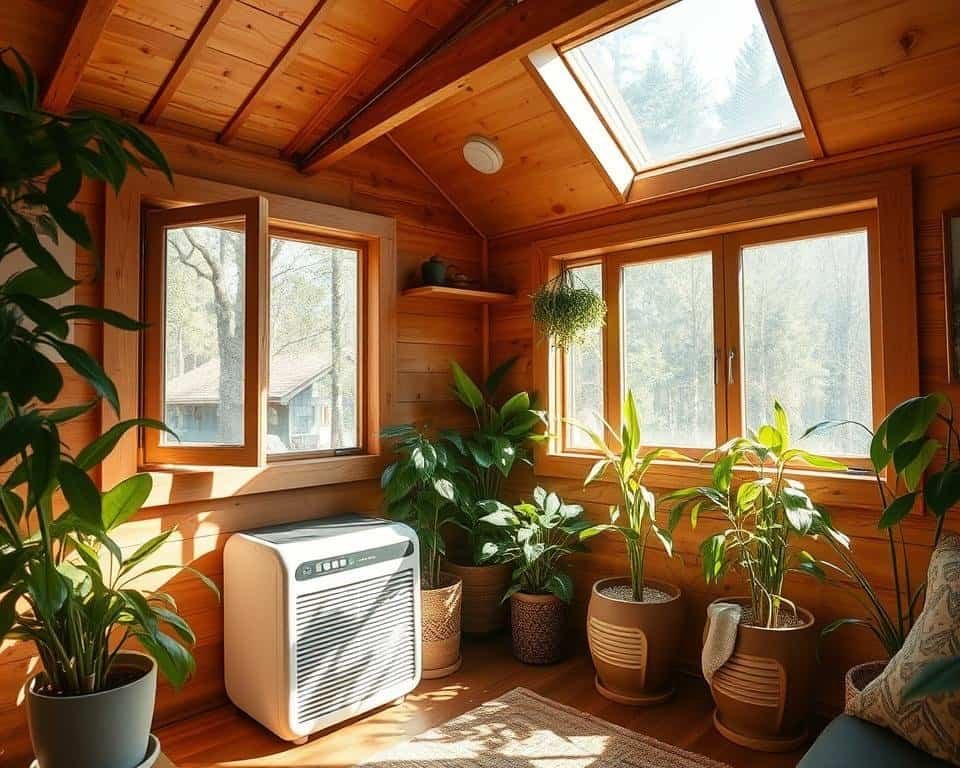Keeping moisture levels down in a tiny house is key to avoiding damp, mould, and damage. It’s important to tackle the special challenges of small spaces when it comes to humidity control. Using the right methods to manage moisture is crucial for a healthy and comfy home.

We’ll look at the main ways to control moisture in a tiny house. This includes using proper insulation, moisture barriers, and good ventilation. These are all vital for keeping humidity in check. By learning how to manage moisture, you can avoid expensive fixes and keep your home a happy, healthy place.
Understanding Moisture Challenges in Tiny Houses
Tiny houses face more moisture problems because they are small and have less air. This makes them more likely to get damp quickly. It’s important to manage moisture well to avoid damage and keep the home healthy.
Moisture can come from bad insulation, not enough air flow, and too much humidity. Moisture prevention tips for small homes include better insulation, air flow, and controlling humidity. For instance, a dehumidifier can lower humidity, and a ventilation system helps air move better, reducing dampness.
Here are some key things to consider for managing moisture in tiny houses:
- Use proper insulation to reduce heat transfer and prevent moisture buildup
- Install a ventilation system to improve air circulation and reduce humidity
- Use a dehumidifier to reduce humidity levels and prevent moisture buildup
By knowing why tiny houses get damp and taking steps to manage moisture, homeowners can protect their homes. This means following moisture prevention tips for small homes and being proactive about moisture levels.
Essential Methods to Control Moisture in a Tiny House
Keeping moisture levels down is key in tiny houses. Too much damp can cause mold, mildew, and harm the structure. To stop these problems, it’s important to use effective ways to reduce damp. One main method is to ensure good insulation, which stops heat loss and keeps moisture out.
It’s also crucial to manage indoor humidity. This can be done with dehumidifiers and good ventilation. Keeping humidity balanced stops moisture buildup and lowers mold and mildew risks. Using moisture barriers, like vapour barriers and waterproof membranes, also helps keep moisture out.
Installing Proper Insulation
Good insulation is vital to reduce heat loss and moisture gain. By insulating walls, floors, and ceilings, you stop cold air and condensation risks.
Using Moisture Barriers
Moisture barriers, like vapour barriers and waterproof membranes, keep moisture out. They can be put in walls, floors, and ceilings for extra protection.
Managing Indoor Humidity Levels
It’s important to control indoor humidity to prevent moisture buildup. Using dehumidifiers and ventilation helps keep humidity balanced. This reduces mold and mildew risks.
Implementing Waterproof Materials
Using waterproof materials, such as paint and sealants, helps keep moisture out. These can seal gaps and cracks in walls, floors, and ceilings. They add extra protection against moisture.
Strategic Ventilation Solutions for Tiny Homes
Proper ventilation is key for control moisture in a tiny house and keeping the air healthy. In tiny homes, it’s vital for removing moisture and improving air quality. Good ventilation stops mold, lowers humidity, and makes living more comfortable.
Natural Ventilation Techniques
Natural methods like opening windows and using vents help remove moisture. It’s simple and saves money, making it great for tiny house owners. Natural ventilation offers:
- Improved air quality
- Reduced humidity
- Increased comfort
Mechanical Ventilation Systems
Mechanical systems, like whole-house fans and heat recovery, also remove moisture and improve air. They work better than natural methods and are good for humid areas.
Smart Ventilation Controls
Smart controls optimize ventilation and cut energy use. They use sensors to check air quality and adjust ventilation. This way, tiny house owners keep their homes well-ventilated, save energy, and maintain a healthy environment for tiny house humidity control.
Daily Habits for Moisture Prevention
Keeping moisture levels down in small spaces is key to a healthy home. Simple daily habits can greatly lower the risk of moisture problems in tiny homes. Cleaning regularly is a top way to stop moisture buildup. This means wiping down surfaces, like in kitchens and bathrooms, to get rid of extra water or humidity.
Storing things properly is also vital for managing moisture. Keeping your stuff tidy helps air move better and stops moisture from building up. Using products like silica gel or desiccants can also keep your space dry. Here are some tips for small homes:
- Use fans and vents to improve ventilation
- Fix any leaks or water damage promptly
- Use a dehumidifier to control humidity levels
By following these easy tips every day, you can keep moisture under control in your tiny home. This makes your living space healthier and more comfortable.
Conclusion
Keeping moisture under control in a tiny house is key to avoiding damp, mould, and damage. By using the right methods like insulation, moisture barriers, and good ventilation, tiny house owners can make their homes healthy and comfy. Also, regular cleaning and smart storage help keep moisture at bay.
Embracing a Proactive Approach
Keeping a tiny home dry and comfy needs a proactive mindset. Owners should watch out for moisture, fix problems fast, and keep an eye on their home’s air. With the right steps and a focus on moisture control, tiny house lovers can enjoy their homes fully.
FAQ
What are the common causes of moisture issues in tiny houses?
Tiny houses face moisture problems due to their small size and limited air flow. Issues like poor insulation, not enough ventilation, and high humidity are common.
How can proper insulation help control moisture in a tiny house?
Proper insulation is key to stopping heat loss and moisture gain. It keeps the temperature and humidity steady, reducing damp and condensation risks.
What is the role of moisture barriers in controlling moisture in a tiny house?
Moisture barriers, like vapour barriers and waterproof membranes, stop moisture from getting in. They act as a physical block, preventing moisture from moving through materials.
How can managing indoor humidity levels help control moisture in a tiny house?
Keeping indoor humidity right is crucial. Dehumidifiers and ventilation systems help remove excess moisture, keeping the air dry.
What are some waterproof materials that can be used to control moisture in a tiny house?
Using waterproof materials, such as paint and sealants, can prevent moisture entry. These materials form a protective layer, stopping water from getting in.
How can natural ventilation techniques help control moisture in a tiny house?
Natural ventilation, like opening windows and using vents, removes moisture. It exchanges moist air for drier air, reducing damp and condensation risks.
What are the benefits of mechanical ventilation systems in a tiny house?
Mechanical systems, like whole-house fans and heat recovery, remove moisture and improve air quality. They manage airflow and humidity efficiently.
How can smart ventilation controls help optimise moisture control in a tiny house?
Smart controls adjust ventilation based on humidity, temperature, and occupancy. They ensure efficient moisture management and save energy.
What daily habits can help prevent moisture issues in a tiny house?
Regular cleaning, proper storage, and good ventilation are key. These habits remove moisture, prevent mould, and improve air quality.




Leave a reply